Next, you will add materials to the barracks. Materials for the barracks use texture maps, as the ammunition canister does, but they also use bump mapping to create a more three-dimensional appearance.
 open army_compound01.max.
open army_compound01.max.

3ds Max displays the barracks in the center of the viewport, and hides the other scene geometry.
 (Orbit) and
(Orbit) and  (Field-Of-View) to adjust the view so you can clearly see the barrack walls.
(Field-Of-View) to adjust the view so you can clearly see the barrack walls.
 (Select Object), then click an empty area of the viewport to deselect the barracks set.
(Select Object), then click an empty area of the viewport to deselect the barracks set.
 display the Material Editor.
display the Material Editor.
 Propagate Materials To Instances to turn it on. (When this option is turned on, a check mark appears before its name.)
Propagate Materials To Instances to turn it on. (When this option is turned on, a check mark appears before its name.)
Like the oil tanks and generators, the barracks objects, roof, walls, and floors, are instances of each other. By turning on this option, you can apply a material to all the objects of one type by dragging and dropping to only one object.
 Material/Map Browser panel, at the left, locate Maps
Material/Map Browser panel, at the left, locate Maps  Standard
Standard  Bitmap, and drag this map type into the active View.
Bitmap, and drag this map type into the active View.
 (Show Shaded Material In Viewport) to turn it on. (If you use a legacy viewport driver, this button's tooltip reads, "Show
Standard Map In Viewport.")
(Show Shaded Material In Viewport) to turn it on. (If you use a legacy viewport driver, this button's tooltip reads, "Show
Standard Map In Viewport.")
The BarracksWalls material now has an image of the planking.

Planks texture for barracks walls
All three barracks now show the BarracksWalls material.
The planks texture shows dirt at the bottom of the wall, but with default mapping coordinates, the dirt appears just above each doorway, instead.

Planks texture appears on the walls, but is not aligned correctly.
Use UVW Map to adjust the planks:
 Select Barracks01-Walls, and then go to the
Select Barracks01-Walls, and then go to the  Modify panel.
Modify panel.
 Mapping group, change the projection type to Box. Also set Length = Width = Height = 4.0m.
Mapping group, change the projection type to Box. Also set Length = Width = Height = 4.0m.
Now the planking texture is correctly aligned with the walls.
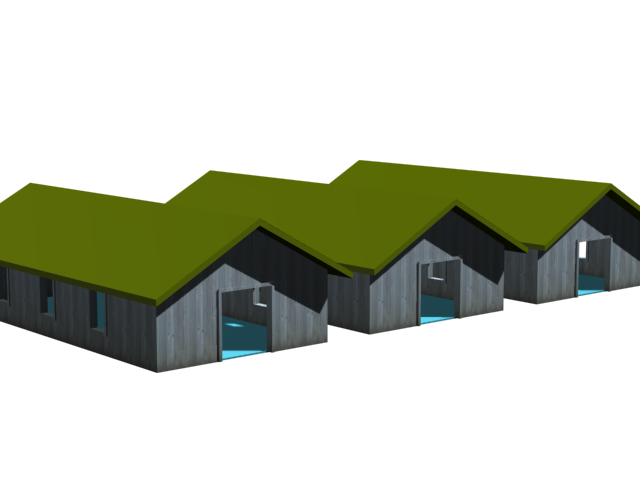
After applying UVW Map, the planks on the walls are aligned correctly.
Add a bump map to the planks material to improve realism:
If you take a closer look at the barracks, you can see that the texture looks good, but it also has a flat appearance, smoother than aged wood typically appears.

Barrack walls with a texture alone, and no bump mapping
You can improve the appearance of the plank walls by using bump mapping. Bump mapping makes an object appear to have a bumpy or irregular surface.
 Material/Map Browser panel, at the left, locate Maps
Material/Map Browser panel, at the left, locate Maps  Standard
Standard  Bitmap, and drag another Bitmap node into the active View.
Bitmap, and drag another Bitmap node into the active View.
3ds Max adds the node to the active View.
This map is simply a black-and-white version of the planks.bmp map itself.
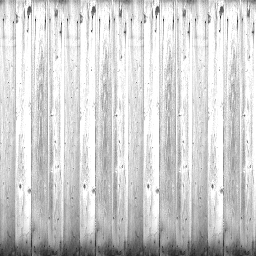
Black-and-white planks texture for bump mapping
Bump mapping uses intensities in the map to affect the surface of the material when you render it: white areas appear higher, and black areas appear lower. This is why the bitmap you use for bump mapping is often a black-and-white version of the map you use for texture.

As it did for the other Bitmap nodes, 3ds Max adds a Controller node for the bump map’s Value.
 (Render Production) to see the effect of the new map.
(Render Production) to see the effect of the new map. 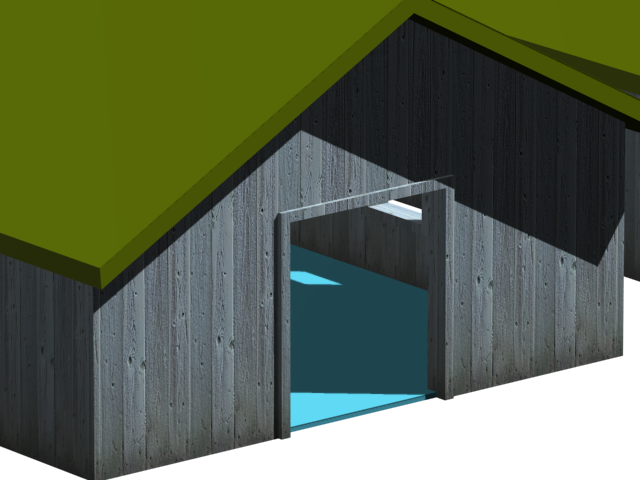
The barrack walls with bump mapping
To get an even more weathered look, you can increase the bump mapping Amount.
 (Render Production) again.
(Render Production) again.
Now the planks appear extremely weathered.
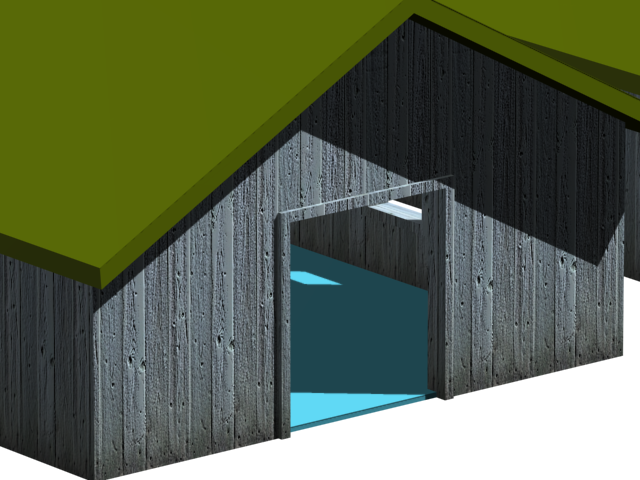
The barrack walls with increased bump mapping
 Field-Of-View so you have a good view of the barrack roofs.
Field-Of-View so you have a good view of the barrack roofs.
 Select Barracks01-Roof.
Select Barracks01-Roof.
 active View.
active View.
 Material/Map Browser panel, at the left, locate Maps
Material/Map Browser panel, at the left, locate Maps  Standard
Standard  Bitmap, and drag this map type into the active View.
Bitmap, and drag this map type into the active View.
 (Assign Material To Selection), and then click
(Assign Material To Selection), and then click  (Show Shaded Material In Viewport) to turn it on. (If you use a legacy viewport driver, this button's tooltip reads, "Show
Standard Map In Viewport.")
(Show Shaded Material In Viewport) to turn it on. (If you use a legacy viewport driver, this button's tooltip reads, "Show
Standard Map In Viewport.")
In the viewport, the map appears on the barrack roofs. However, it is oriented the wrong way: the corrugated plates should lie along the slope of each roof instead of lengthwise.
 Modify panel, and use the Modifier List to apply a UVW Map modifier.
Modify panel, and use the Modifier List to apply a UVW Map modifier.
At first this appears to lose the W-Angle correction you just made, but changing the modifier alignment will fix that.
 Alignment group, choose Y as the alignment axis.
Alignment group, choose Y as the alignment axis. 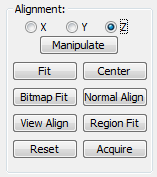
 Mapping group, change Length to also equal 7.04m.
Mapping group, change Length to also equal 7.04m.
(Make sure you leave the UVW Map projection set to Planar, the default.)
 Material/Map Browser panel, at the left, locate Maps
Material/Map Browser panel, at the left, locate Maps  Standard
Standard  Bitmap, and drag another Bitmap node into the active View.
Bitmap, and drag another Bitmap node into the active View.
 (Render Production) to see the effect.
(Render Production) to see the effect. 
The barrack roofs with bump mapping
At the eaves of the roofs, the texture “slops over” a bit. In this scene, it isn’t a problem because usually you will render the barracks from a distance. Of course, the bump mapping isn’t too apparent at a distance, either. Whenever you texture a scene, bear in mind how much detail you want to use to make the scene believable.
 Select Barracks01-Floor.
Select Barracks01-Floor.
 (Assign Material To Selection), and then turn on
(Assign Material To Selection), and then turn on  (Show Shaded Material In Viewport). (If you use a legacy viewport driver, this button's tooltip reads, "Show Standard Map
In Viewport.")
(Show Shaded Material In Viewport). (If you use a legacy viewport driver, this button's tooltip reads, "Show Standard Map
In Viewport.")
 Apply a UVW Map modifier to Barracks01-Floor. Leave the projection set to Planar. Set Length = Width = 4.0m.
Apply a UVW Map modifier to Barracks01-Floor. Leave the projection set to Planar. Set Length = Width = 4.0m.
You don’t need to adjust the orientation of the floorboards.
Now the barracks are completely textured.
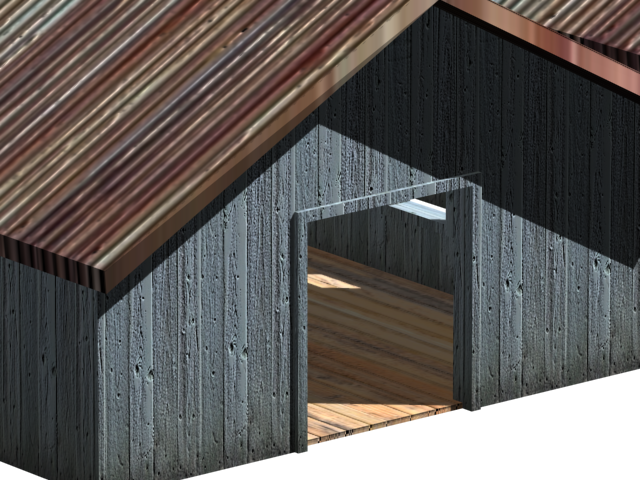
Close-up of one barrack with textures for roof, walls, and floor
Use the Barrack Materials for the Sentry Box
Now that you have textured the barracks, you can use the same materials for the sentry box. The trick is to use the same materials and the same UVW Map settings.
 Camera02.
Camera02.
This gives you a view of the completed barracks, and the unfinished sentry box.
The new view lets you see the roofs, walls, and floors of the completed barracks, and also the roof, walls, and floor of the sentry box, which doesn’t yet have materials applied.

Camera02 view with finished barracks to the right, unfinished sentry box to the left.
Changing to a perspective view doesn’t change what appears in the viewport, but in the perspective view, you can navigate without changing the camera settings.
Copy the barracks floor material:
 Click one of the Barracks0X-Floor objects to select it.
Click one of the Barracks0X-Floor objects to select it.
 Ctrl+drag the UVW Mapping entry in the floor object’s modifier stack, and drop this modifier instance over the floor of the sentry
box. (Before it has a material, the floor appears blue.)
Ctrl+drag the UVW Mapping entry in the floor object’s modifier stack, and drop this modifier instance over the floor of the sentry
box. (Before it has a material, the floor appears blue.)
The sentry box floor now has the correct mapping, but it still needs its material.
Now the floor has both the material and the correct mapping.
Copy the roof and wall materials:
If the material is no longer visible in the active View of the Material Editor, then on the Browser panel open the Scene Materials group, drag the material into the active View, and choose Instance.

The sentry box with the same materials as the barracks
Create a new, 3D material for the sentry bar:
For the sentry bar, which blocks or permits vehicle access to the compound, you can use a simple material with a procedural map named Gradient Ramp.
 (Orbit) and
(Orbit) and  (Field-Of-View) to adjust the view so the sentry bar is clearly visible.
(Field-Of-View) to adjust the view so the sentry bar is clearly visible. 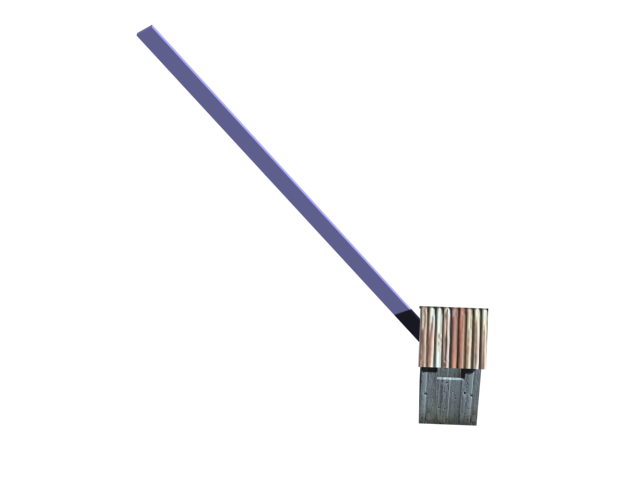
Isolated sentry box with a view of the bar
 Select the sentry-bar object.
Select the sentry-bar object.
 Maps
Maps  Standard group, drag a Gradient Ramp node into the active View. Wire this node to the Diffuse Color component of the SentryBar material.
Standard group, drag a Gradient Ramp node into the active View. Wire this node to the Diffuse Color component of the SentryBar material.
 (Assign Material To Selection) and
(Assign Material To Selection) and  (Show Shaded Material In Viewport). (If you use a legacy viewport driver, this button's tooltip reads, "Show Standard Map
In Viewport.")
(Show Shaded Material In Viewport). (If you use a legacy viewport driver, this button's tooltip reads, "Show Standard Map
In Viewport.")
Gradient Ramp is a 3D procedural material like the Noise material you used for the generator casings.

The gradient display changes to two solid colors, one of them black.
The material changes from two color areas to multiple stripes.
Now the stripes have an angle to them.

Isolated sentry box with the completed sentry bar
 Camera01.
Camera01.